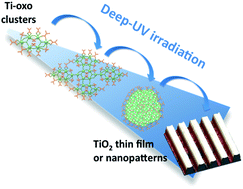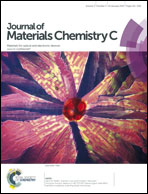Room-temperature preparation of metal-oxide nanostructures by DUV lithography from metal-oxo clusters
Abstract
A versatile, fast and easy route towards preparation of metal-oxide nanostructures by a full-optical method at room temperature is presented here. The concept relies on the preparation of photosensitive metal-oxo clusters (MOCs) that can be crosslinked and mineralized in a single step process, by Deep-UV (DUV) irradiation (ArF laser emission band at 193 nm). The oxo-clusters are prepared by complexation between metal alkoxides and methacrylic acids followed by a partial hydrolysis. These molecular building blocks are designed to absorb DUV light and they can react from an excited state to give rise to crosslinking reactions. Photocrosslinking of Ti, Zr and Hf oxo-clusters was investigated by means of in situ FTIR and spectroscopic ellipsometry. In the case of Ti-oxo clusters, we demonstrate that the material can be fully mineralized into TiO2 by DUV irradiation. A photocatalytic process involving TiO2 nanoparticles is proposed to explain the DUV mineralization process. Finally, we used DUV interferometric lithography to illustrate nanopatterning based on these photoresists. These inorganic photoresists open new doors towards room temperature preparation of high-resolution inorganic nanostructures with strong interest for practical applications in electronics, optics, photonics or biology.


 Please wait while we load your content...
Please wait while we load your content...